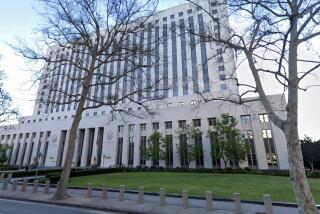Fine-Feathered Census
He was scanning the sky with powerful binoculars and a tripod-mounted telescope.
They were waddling along the ground, their tiny eyes darting over the pavement.
No matter. The pigeons still beat Larry Allen at spotting the distant silhouette of the peregrine falcon that was swooping gracefully Sunday above high-rise office towers in downtown Los Angeles.
Allen was falcon-hunting from a rooftop patio at the Bonaventure Hotel. His perch was the most unusual during the National Audubon Society’s annual Christmas Bird Count in Los Angeles County.
But the pigeons saw the falcon first.
With a noisy flutter of wings, a dozen of them suddenly lifted off the patio and flew to the cover of nearby hotel trees as the falcon made a lazy circle and then disappeared behind a 48-story building at 444 S. Flower St.
Allen swung his telescope toward the building and trained his binoculars at its top ledge. He was hoping for another glimpse of the falcon--an elusive bird that is making a slow comeback from near extinction caused by DDT insecticide poisoning 30 years ago.
“I’m looking for a little bump on the edge of the highest building,” Allen said. “The peregrine scared the pigeons. They stay alert for danger--they saw it up there.”
The falcon is part of a pair of peregrines that nest in a gravel-filled box on a ledge behind the Union Bank sign atop a 40-story Figueroa Street building. Four other breeding pairs have been placed on high-rises in the Wilshire district, Glendale and Santa Monica and on the Vincent Thomas Bridge in San Pedro, according to Audubon officials.
The pigeons were wise to move along. Peregrine falcons are the fastest birds aloft, rocketing along at more than 200 miles per hour when dive-bombing for lunch.
Unfortunately for Allen, the pigeons were wise enough to keep a low profile Sunday during the rest of the hour that he spent on the hotel patio counting birds.
About 45,000 volunteer bird-watchers in the United States and Canada are taking part in this year’s 98th annual Christmas Bird Count, which runs from Dec. 19 to Jan. 4. Forty-five spotters were positioned Sunday in a 15-mile-wide area that stretched from North Hollywood to Inglewood.
The annual count helps experts track migration habits and chart the rise and fall of bird populations.
Los Angeles count coordinator Kenneth Freeland, 35, a Malibu management consultant, said that about 130 species were tallied by the spotters during a seven-hour period.
The most unusual find was a Wilson’s warbler, spotted in a grove of trees at UCLA by counter Kendall Kroesen, a 37-year-old researcher from Mar Vista. The warbler normally would have been wintering in the Central America area, Freeland said.
The peregrine falcon was almost killed off when DDT began causing eggs laid by females to have thin shells. It owes its recovery to captive breeding efforts by federal and state biologists supported by several raptor study centers and the national Peregrine Fund.
Allen was not upset that he only spotted one of the birds Sunday. He said that in past years he had not seen either of them during the Christmas Bird Count.
Thanks in part to the pigeons, the 51-year-old El Sereno property manager came away with a tally sheet filled with bird observations.
At six locations he visited in the downtown-LaFayette Park area, Allen spotted five pied-billed grebes, a double-crested cormorant, five ring-necked ducks, one red-tailed hawk, 33 Anna’s hummingbirds, 12 black Phoebes, one bushtit, 250 brewer’s blackbirds, a Western scrub jay, three Northern finches, three ruby-crowned kinglets, one American kestrel and 800 rock doves.
“ ‘Rock dove’ is the fancy name for ‘pigeon,’ ” Allen explained.
More to Read
Sign up for Essential California
The most important California stories and recommendations in your inbox every morning.
You may occasionally receive promotional content from the Los Angeles Times.







